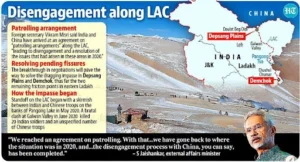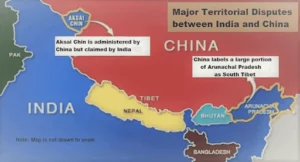Introduction
- In a significant diplomatic development, India and China have recently agreed to new patrolling arrangements along the Line of Actual Control (LAC), marking a potential easing of tensions that escalated after Chinese incursions in 2020.
- While this agreement is a welcome step towards restoring peace along the border, unresolved “legacy disputes” such as Demchok and Depsang remain major points of concern.

Key Features of the India-China LAC Agreement
Restoration of Patrolling Protocols:
- The agreement allows both India and China to resume regular patrols along established routes, effectively aiming to return to the pre-2020 status quo. This is crucial for maintaining order and clarity along the disputed border and helps to minimize accidental confrontations.
Read also: South India’s Ageing Population: Healthcare & Social Services | UPSC
Disengagement Process Completion:
- Another key aspect of the agreement is the completion of the disengagement process. This has been a focal point of negotiations for the past four years, aimed at pulling back troops from friction points along the LAC, including areas such as Pangong Tso and Gogra-Hot Springs.
Reduction of Military Presence:
- Both sides have agreed to reduce the number of troops stationed in key areas to prevent further confrontations. To ensure compliance, the agreement also establishes regular monitoring and review mechanisms, enabling both nations to track the implementation of the protocols effectively.

Implications of the India-China LAC Agreement
De-escalation of Military Tensions:
- The agreement is a significant move toward reducing tensions along the LAC, which has seen heightened military activity since 2020. By scaling back the presence of troops and resuming patrolling protocols, the chances of another confrontation, such as the Galwan Valley clash, are reduced.
Revival of Diplomatic Relations:
- If successfully implemented, this agreement could pave the way for the resumption of high-level diplomatic engagements between India and China in forums like BRICS and the Shanghai Cooperation Organisation (SCO). It opens the door for more productive discussions on a range of bilateral and regional issues.
Boost to Economic and Trade Ties:
- A reduction in military tensions can also positively impact economic relations. For example, the resumption of flights and the potential for increased Chinese investment in India are likely outcomes of normalized relations. These economic improvements could benefit both nations, especially in the post-pandemic recovery phase.
Regional Stability and Geopolitical Impact:
- A more stable India-China relationship could have ripple effects across Asia. Neighboring countries with territorial disputes involving China may take note of the peaceful resolution of the LAC dispute, potentially influencing their own negotiations. This stability could also enhance cooperation in broader regional frameworks.
Future Resolution of Legacy Disputes:
- While the agreement addresses current tensions, it also sets the stage for resolving long-standing territorial disputes. The regions of Demchok and Depsang remain unresolved, but this agreement may serve as a foundation for future negotiations aimed at tackling these issues.
Challenges in Resolving the India-China Border Dispute
- Legacy Border Issues: The origins of the India-China border dispute date back to the 1962 war. Long-standing disagreements over key regions like Demchok and Depsang remain unresolved, and these legacy issues make it difficult to reach a comprehensive solution.
- Unilateral Actions by China: China’s repeated attempts to unilaterally alter the status quo along the LAC, such as military incursions into Indian territory, have created mistrust. These actions have escalated tensions in the past and remain a barrier to sustained peace.
- Strategic and Nationalistic Pressures: The LAC holds strategic importance for both nations, with national security concerns intertwined with territorial claims. Nationalistic sentiments on both sides further complicate negotiations, as neither country wants to appear weak by conceding territory.
- Military Build-up Along the LAC: Both India and China have significantly ramped up their military infrastructure and troop deployments along the border. This build-up makes disengagement a complex process, as neither side wants to give up strategic advantages gained in recent years.
- Trust Deficit Following Galwan Clashes: The deadly Galwan Valley clash in 2020 has severely damaged trust between the two countries. This lack of trust creates a volatile environment, making it challenging to achieve long-term peace and stability. Rebuilding this trust will require more than just agreements; it will require consistent confidence-building measures over time.
- Imbalance in Buffer Zones: During the disengagement process, the creation of buffer zones has reportedly led to India losing more ground than China. This perceived imbalance is a source of frustration for India and adds another layer of complexity to the resolution process.
Read also: Supreme Court Urges Stronger Laws to End Child Marriages | UPSC
Way Forward
- Sustained Dialogue and Negotiations: India and China must continue engaging in high-level talks. Keeping diplomatic, military, and political channels open will be essential for maintaining peace along the LAC and resolving deeper issues like Demchok and Depsang.
- Rebuilding Trust: Both sides need to take active measures to rebuild trust, such as refraining from unilateral actions that could destabilize the situation. Mutual respect and adherence to agreed protocols will be crucial for fostering a stable border environment.
- Addressing Legacy Disputes: Future negotiations should focus on resolving the long-standing disputes over regions like Demchok and Depsang. A comprehensive solution will require addressing these historical grievances, not just managing current tensions.
- Balanced Disengagement: Any future disengagement must be balanced, ensuring that neither side disproportionately loses territory when creating buffer zones. A fair and equitable approach to disengagement will help build confidence and contribute to a more sustainable resolution.
Conclusion
The India-China LAC agreement marks a significant step forward in reducing border tensions and improving bilateral relations. However, the road to a lasting resolution remains fraught with challenges, particularly regarding long-standing disputes and the rebuilding of trust. Continued dialogue, mutual respect, and a balanced approach to disengagement are essential for achieving long-term peace along the LAC. If both nations remain committed to these principles, the recent agreement could serve as the foundation for a broader resolution to the India-China border dispute.

